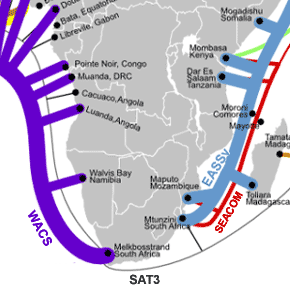International bandwidth finally on the horizon for DR Congo
Recent figures on the actual rate of Internet penetration in the DRC are hard to find, but it’s safe to say the Internet is still very elitist in DR Congo. In large cities, the Congolese have access to the Internet in cybercafés mainly to read and send emails. More and more young people go to cafes to use social networks, but the very slow connection speed generally prevents video playback. That will gradually change once international fibre is introduced and when 3G coverage eventually begins.
Although DR Congo’s politics are known to greatly hinder international bandwidth from arriving (read on), there is promising telecoms news:
- Mobile operators Airtel, Africell (just launched this year), Oasis, and Vodacom each purchased a 3G license in July 2012
- A major government-sponsored program aims to build telecoms infrastructure through a public-private partnership (PPP). By 2016, the plan hopes to lay 5,000km of fibre backbone, begin e-government measures, and connect 30 million fixed and mobile lines. Amazing news, but difficult to achieve given the challenges surrounding WACS participation.
- Airtel, DRC’s largest mobile operator, plans to invest an additional USD615 million over the next three years
- In May, Huawei Africa, a global ICT services provider, inaugurated a state-of-the art training center in Kinshasa
- Feasibility studies to provide broadband in North Kivu, South Kivu and Katanga were conducted in 2012. A backbone cable will connect to either WACS or EASSy
- The ACE undersea cable is to land in Muanda sometime later in 2012, thus providing additional international bandwidth and redundancy
Although there is plenty of positive ICT news coming out of the Democratic Republic of the Congo this year, most reporting revolves around the failure to capture access to the recently launched West Africa Cable System (WACS) fibre cable. South Africa, Namibia, Botswana, and Nigeria are already enjoying the benefits of enhanced international bandwidth. Unfortunately, DRC remains unlinked to the 5 Tbit/s (500 Gbit/s at launch) cable. The ACE cable is scheduled to make a landing later in 2012, but is behind schedule due to other reasons.
In March, we mentioned how the Congolese government and private sector have an ineffective relationship that has prevented the WACS landing station from becoming a reality (emphasis on the government). Voice of America wrote an excellent article on the matter back in May, so we won’t rehash every point. Still, a few highlights should be reiterated:
- As of May 2012, the country was “officially” four months behind schedule in connecting to WACS (and now is six months late)
- A Muanda-Kinshasa cable installed 3 years ago is ready to be activated
- Congolese Society of Post and Telecommunications (SCPT) is still confident a landing of WACS can happen before September (ostensibly before Kinshasa plays host to the Sommet de la Francophonie in October)
- Connecting remote parts of DRC to fibre in Zambia, Rwanda, or Uganda could be potentially cheaper than connecting to Kinshasa or the Muanda landing station
A timeline of Congolese news sources adds perspective to the overly complex ordeal of securing international bandwidth. Hope is on the horizon:
- May 17: The deputy director general of the Congolese Society of Post and Telecommunications (SCTP) attended the launch of the WACS project in South Africa. He reaffirmed that all players are committed and the SCPT is competent to complete the project by late August. {Radio Okapi via AfriqueJet}
- June 8: The Minister of Posts, Telecommunications and New Information Technologies and Communication, Kin Kiey Mulumba addressed the National Assembly to clear up questions about the shady history of fibre in DRC. No promise was given to have WACS operational this year, but the Minister did admit that $3 million was diverted, but only $300,000 was recovered. {Group l’Avenir}
- June 25: The Minister of SCPT says he is putting pressure on company tasked with constructing the landing station in Muanda. The station should be completed by the end of July 2012. However, the technical aspects will be managed by a French company and no launch date was given. {Caritas Congo Asbl}
- July 5: Two experts from Alcatel visited DRC in June to check on the quality of the landing station in Muanda. They approved of its current construction. {Digitalcongo.net}
- July 24: Work at the landing station in Muanda is well underway, but the Congolese government still owes WACS $5.14 million. {Ecofin}
- August 27: SCPT claims work at the Muanda landing station is completed and ready for testing. The cable is still expected to be live by October’s Francophone Summit. {Kongo Times}
All signs suggest the WACS cable will now be active by October’s Francophone Summit later 2013, especially considering how SCPT just awarded 3G licenses to four mobile operators. In addition, the ACE cable is still scheduled to land in Muanda later this year (note: the cable was officially launched in July 2013). This cable could potentially go live before WACS, although such an event is unlikely. Still, 2012 is poised to mark the beginning of widespread Internet access. 2013 will most likely mark the start of 3G service (note: Airtel indeed launched 3.75G service in May 2013).













 Twitter
Twitter Facebook
Facebook Pinterest
Pinterest